Disclosure: Meeple Mountain received a free copy of this product in exchange for an honest, unbiased review. This review is not intended to be an endorsement.
In this review anything that might be considered a spoiler is hidden in a collapsible window with a spoiler alert on it. In all other ways, this review is spoiler-free.
Escape Tales: Low Memory is a standalone story-driven escape room game in the Escape Tales series. In this game, you and up to three other players play through three different, interconnected files (read: story lines) that can last up to three hours each. In each file, you’ll work cooperatively to gain information, solve puzzles, and make decisions that will affect the outcome of that file’s story — and the game’s overall narrative. There is no “winning or losing” in Escape Tales: Low Memory; the focus is on the gameplay experience and the story that unfolds as you play, but that’s not to say that some outcomes aren’t worse than others.
If you’re already familiar with the first Escape Tales game (The Awakening), you can jump ahead to the section where I note differences between it and Low Memory. Otherwise, continue reading on to learn more about Escape Tales: Low Memory.
01010111011001010010000001100001
The Files and Storybooks
To play Escape Tales: Low Memory, you’ll go through three different files that each put you in the shoes of an individual. Because of how the game’s story develops and the information you gain, the files need to be played in order, starting with File 01: Elizabeth Weber.
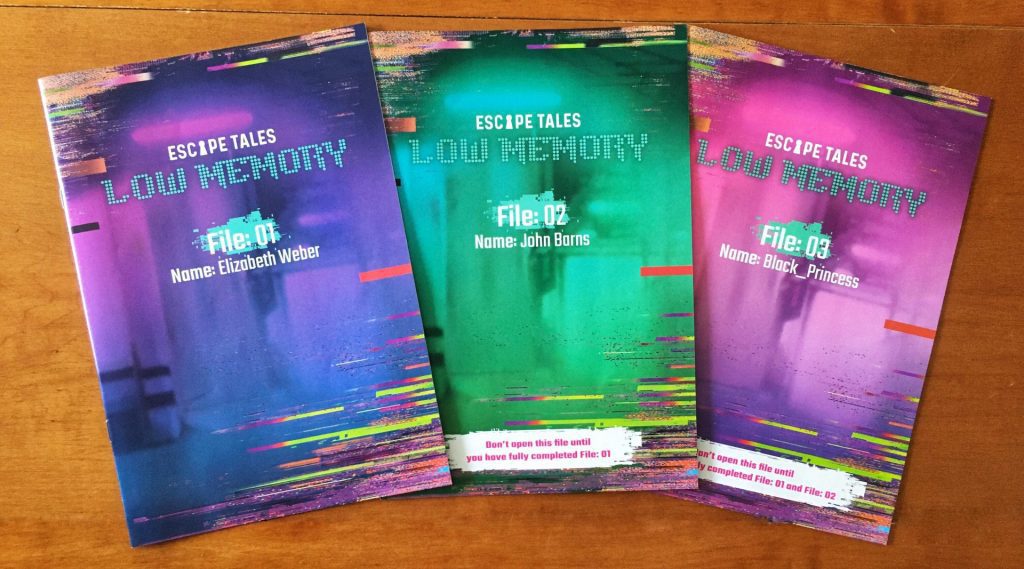
Each file has its own Storybook that contains numbered paragraphs that detail the story’s events and give you instructions to follow. A paragraph in the Storybook might tell you to take or discard Cards or Tokens, read another paragraph, or signal the end of the file’s story. The paragraphs are randomly laid out in the Storybook to minimize any potential spoilers; this means that you might read page 6 paragraph 112 then be required to jump to page 13 paragraph 161 to continue the story. Thankfully the margins of each page indicate which paragraphs are found there so you won’t have to nonsensically flip through the Storybook.
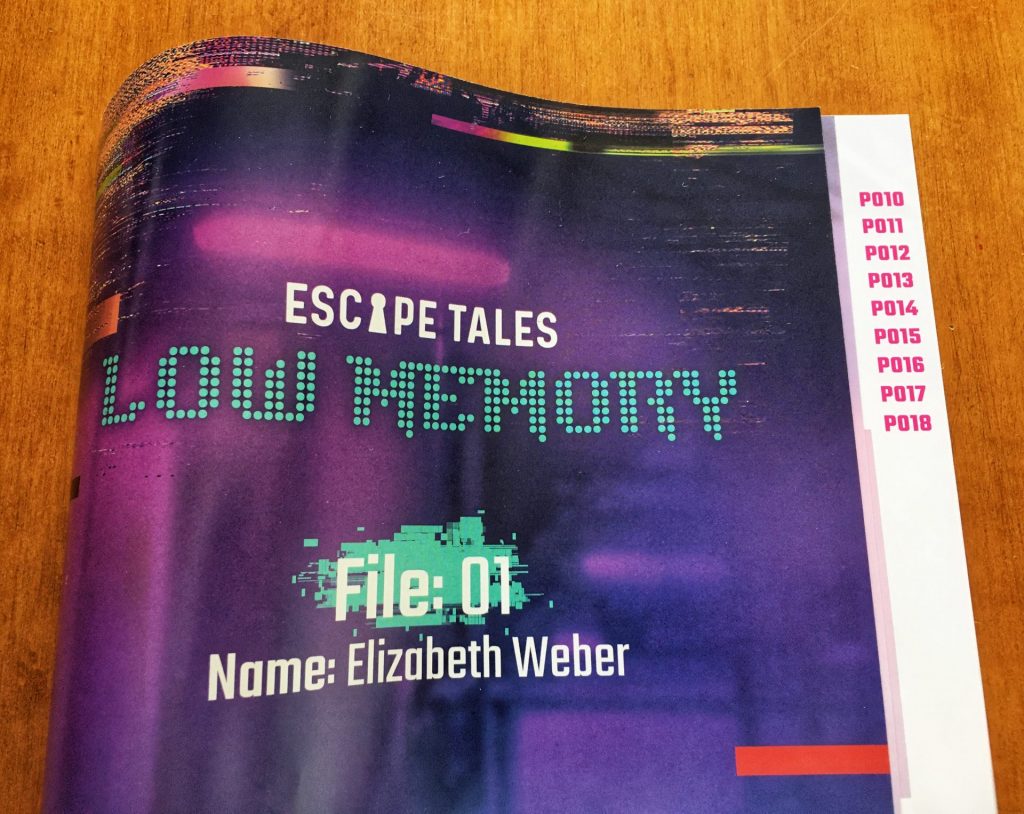
Overall the rules for the three files are the same, but there are some changes to the file’s individual setup, which are also outlined clearly in the Storybooks.
01110010011001010010000001101100
Components and Setup
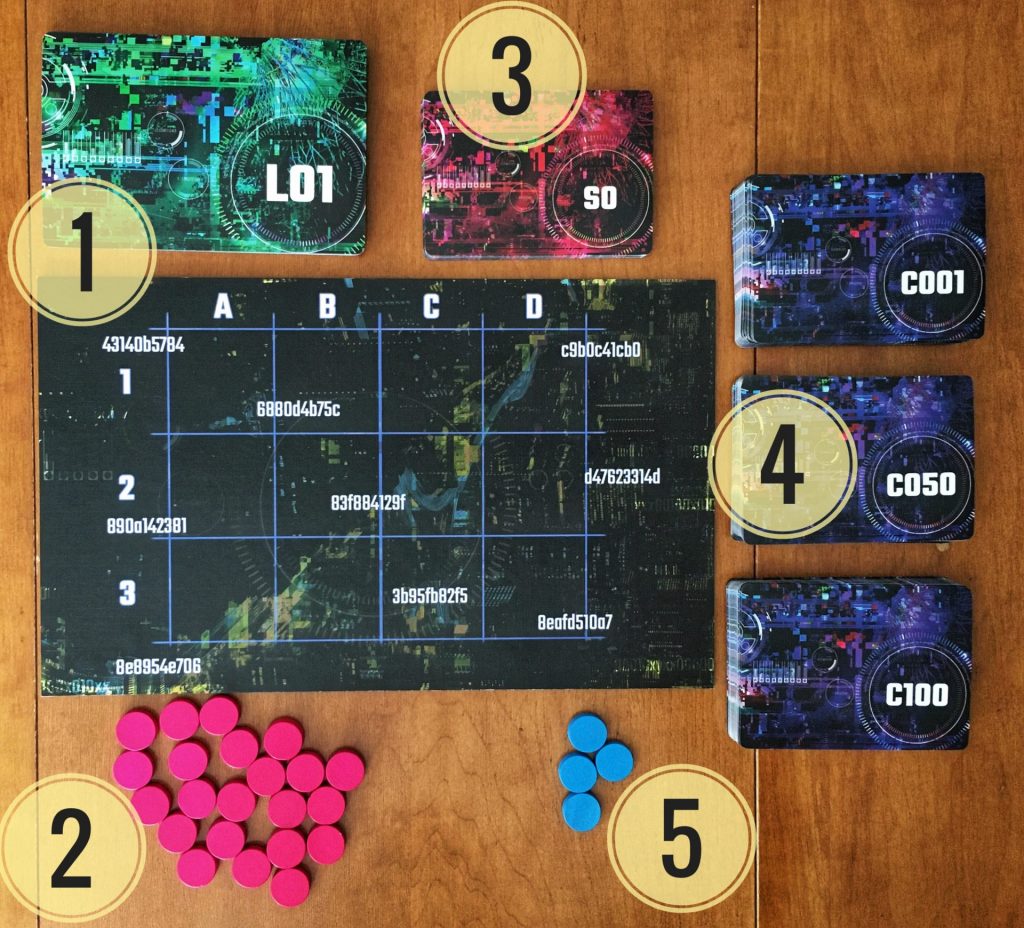
There is more to Escape Tales: Low Memory than just its story — it’s also an escape room style game. The exploration and most of the puzzle components are found outside of the Storybook.
The Location Cards and Game Board (1)
These two components are used to set the story’s scene. Location Cards are placed on the Game Board and the grid corresponds to areas of the location that can be explored by placing Action Tokens (2) on the location’s (smaller) matching Game Card (4).

Action Tokens (2)
The Action Tokens in Escape Tales: Low Memory are used to prevent players from exploring every single area of the game. Managing this resource adds a lot of tension to the game because you inevitably always feel like you never have enough. Thankfully, you usually gain more Action Tokens when you travel to other locations or solve extra puzzles. There is also another way to gain Action Tokens, through Stress Cards (3), but doing this comes at a cost.
Stress Cards (3)
Each file has its own set of Stress Cards that can be used to gain more Action Tokens, but they also generally act as a negative event that takes place within that file’s story. The balancing act between when to save Action Tokens or splurge and use a Stress Card is an interesting aspect of Escape Tales: Low Memory (especially when you sometimes feel the game push you towards taking a Stress Card).
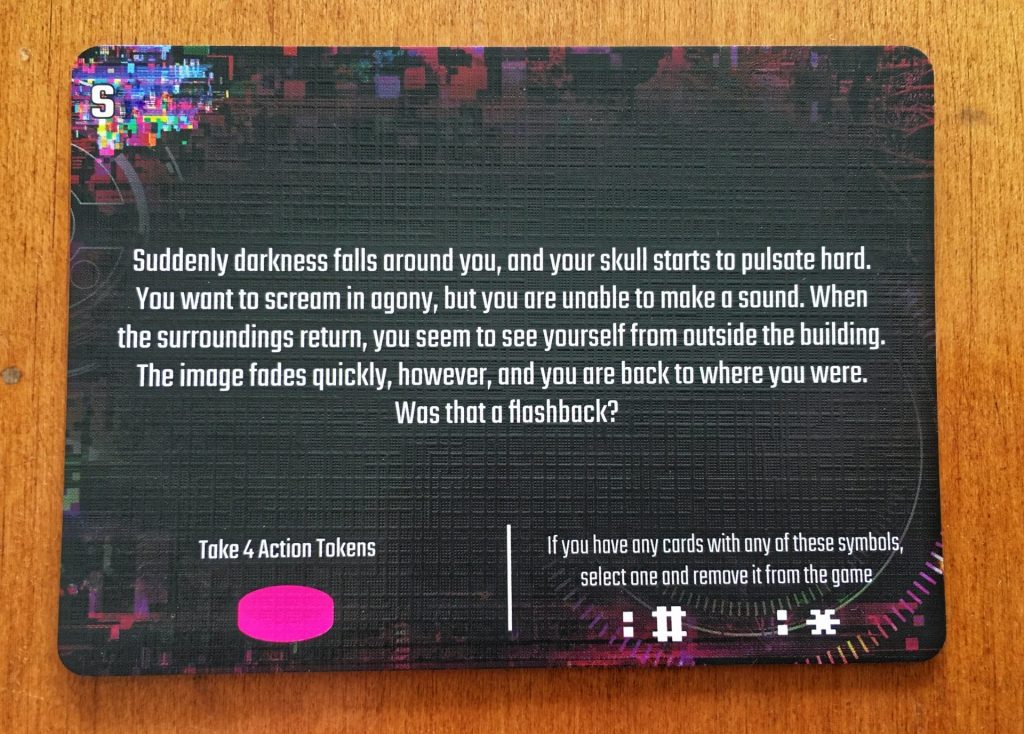
Game Cards (4)
Escape Tales: Low Memory has a big ol’ stack of Game Cards. These cards are divided into six different types: Puzzle Cards, Item Cards, Condition Cards, Pending Cards, Map Cards, and Story Cards.

Puzzle Cards (4a) have a combination of letters/numbers on a pink background in the bottom righthand corner. Cards with the same combination need to be used together in some way to solve that particular puzzle. When you travel to a different location, unused (extra) Puzzle Cards are discarded. Don’t worry if the game takes you to a new location before you’ve solved every puzzle where you were. You won’t accidentally progress through a file before completing all the necessary steps and puzzles.
Item Cards (4b), represented by their dark background, are objects you might gain while playing a file that could be useful later. As such, Item Cards remain with you as you move from one location to another within a file. For example, you might find an Item Card depicting a shovel in the basement, but it’s not until you move outside that you find a use for it.
Condition Cards (4c) are exactly as they sound; the Card specifies a certain condition (have a specific card, for instance) and once you meet the condition, you read the paragraph written on the Condition Card.
Pending Cards (4d) are similar to Condition Cards, but you have to earn and place a number of Progress Tokens (5) on the Card before you can resolve it and read the corresponding paragraph.
Map Cards (4e) are Game Cards that represent the various areas to explore on Location Cards by spending Action Tokens. The Map Cards also demonstrate how to set up the Location Cards; they might tell you, for example, to place the teddy bear on A3 and the bicycle on D1.
Finally Story Cards (4f) highlight important information for both the file’s story and the overall narrative of the game. Story Cards will always have one of the following symbols: : *, : #, or : < . These Cards are special in that they are the only Cards that you are allowed to carry over from one file to another.
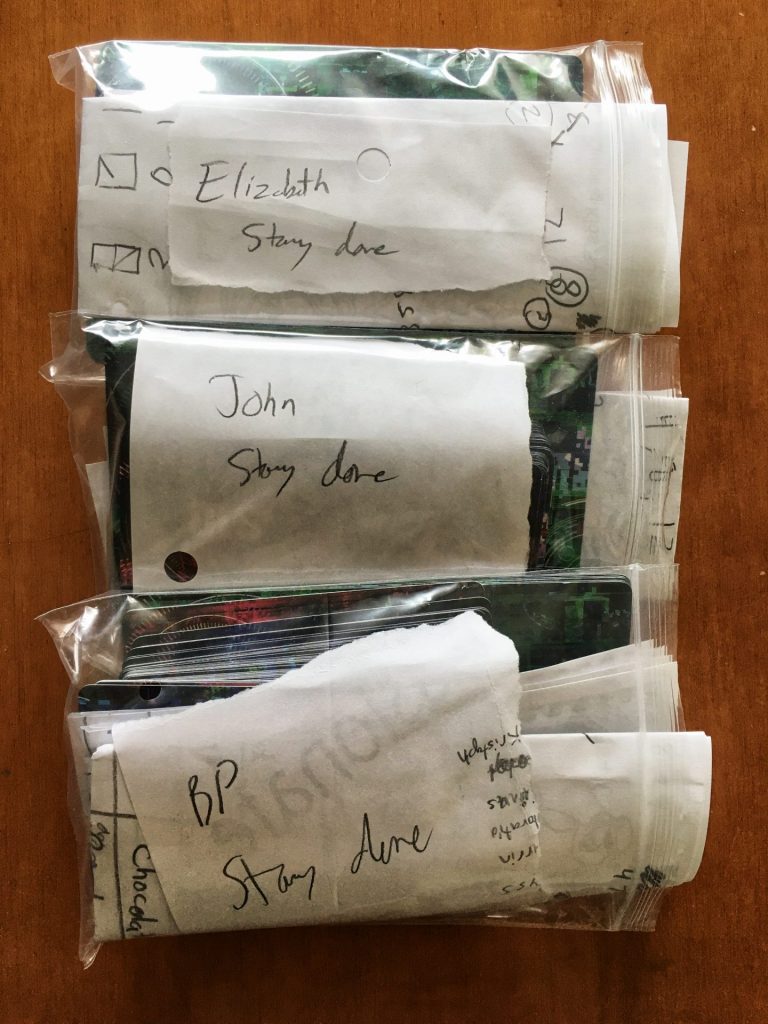
The App/Website
The last component required to play Escape Tales: Low Memory is the “app” (the rulebook calls it an app, but it’s really just a website that is available to use offline). The main use for the app is to input your answer to a puzzle. Then it provides you with next steps — read a specific paragraph, earn Tokens, or draw Game Cards.

The app also features hints for each puzzle, which can be taken freely and without consequence. Similar to the hint system in Exit: The Game, the hints in Low Memory are tiered: the first hint is broad, but each clue gets more detailed with every hint you take until finally you reach the answer. Additionally, the app tells you what components are required to solve a puzzle — four Puzzle cards, for instance — so you can determine if you are even ready to solve a puzzle yet before you choose to take a hint.
01100101011001110110100101101111
Saving the Game
At any point during your Escape Tales: Low Memory adventure, you can pause and save your gameplay using the table at the back of the rulebook, but it’s recommended you do so in between files or upon leaving a location so you don’t forget any details for unsolved puzzles.
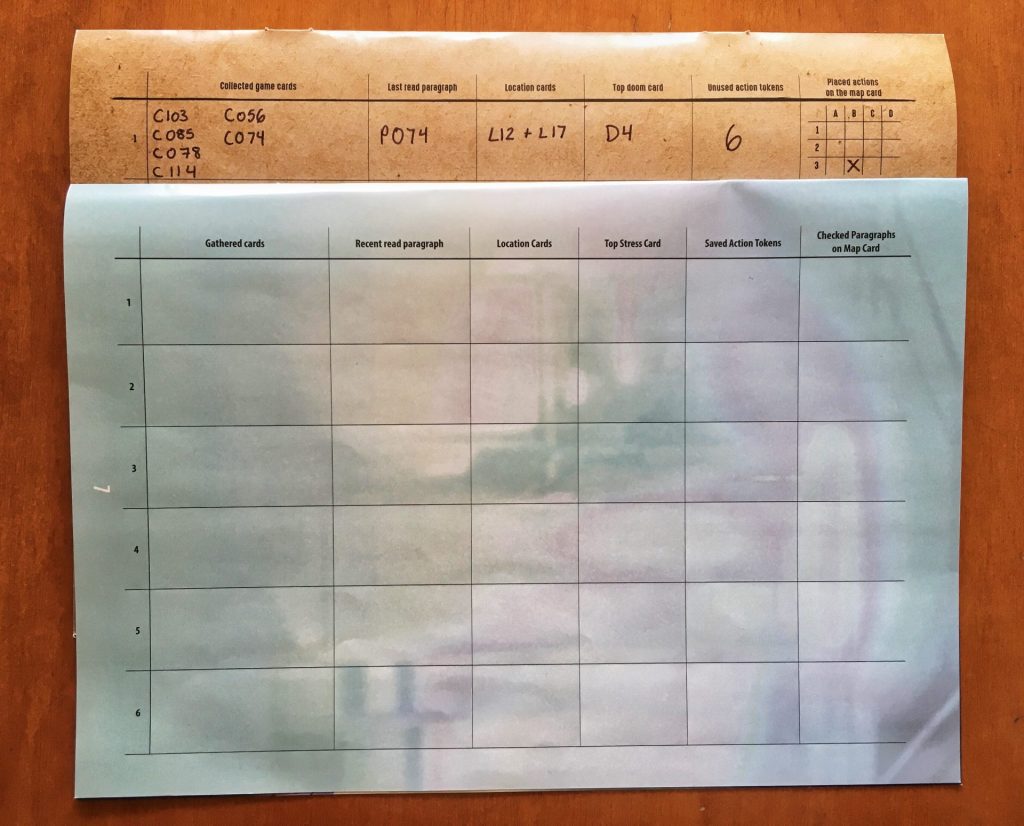
Escape Tales: Low Memory is a very long and difficult game so while you can play it all in one sitting, you’re encouraged to stop after each file’s story is concluded.
01101110001011100010000001010011
The End
One of the unique elements of Escape Tales is just how many different endings there are — this includes both multiple endings for each file, as well as the game overall. This is because players are making so many decisions over the course of each file. Some of the decisions you make are relatively insignificant, while others can drastically alter the file’s conclusion.
Thanks to these branching paths and decision points, you won’t experience everything that Escape Tales: Low Memory has to offer in your first complete playthrough. Luckily the game is replayable because there is no component destruction or manipulation AND there is enough content in the game that you can replay it and still discover new information, items, and puzzles.
Armed with this information, you can go into Escape Tales: Low Memory ready to make a flowchart of all the decision points…that is if you’re a completionist like me.
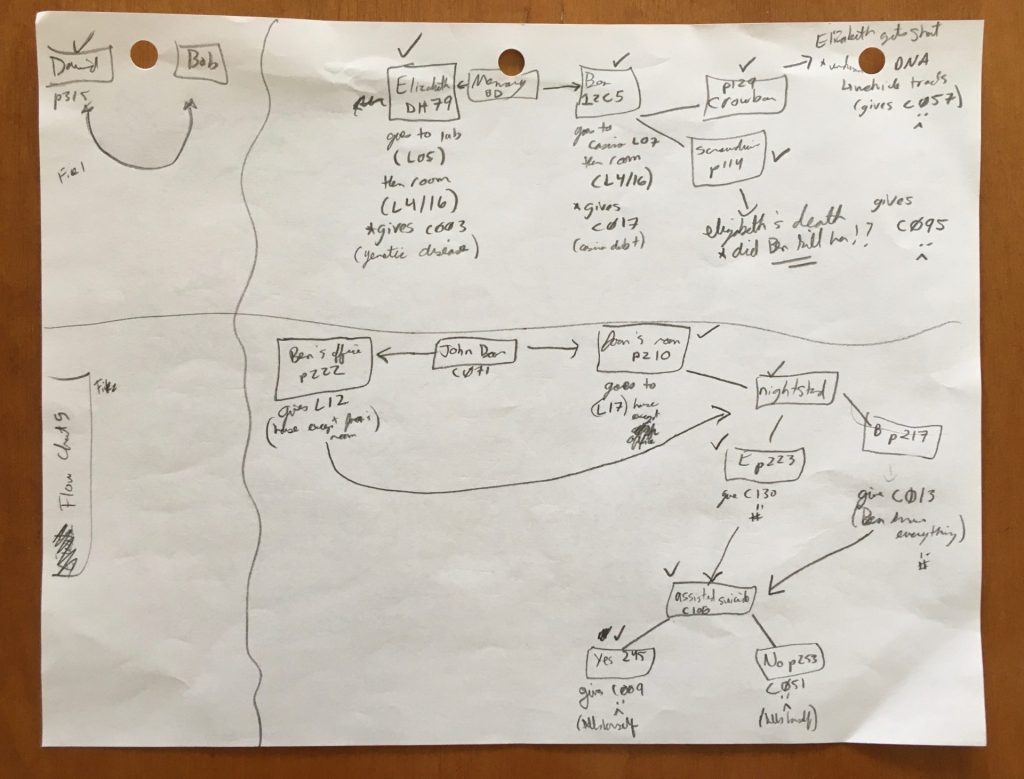
6 Tips to Get the Most Out of Escape Tales
Some of these tips were originally included in my review of Escape Tales: The Awakening, but some are specific to Low Memory’s gameplay.
-
- Break your games up into sessions and don’t be afraid to use the saving system. If you record everything as indicated, you will easily jump right into your next play.
- Don’t burn through Stress Cards by trying to explore every area. You won’t look at every card, use all the items, or even solve all the puzzles in just one play of the game.
- Check and double-check that you are not accidentally discarding Story Cards. Some of the Card symbols (the colon faces like this :’^) look very similar and you don’t want to discard something you need in a later file.
- Dust off your grade 10 mathematics book and start studying. This game is very math heavy — in all strands — so if you aren’t a math person, you had better find someone who is to team up with.
- Play the Tutorial found at the beginning of File 01. While it isn’t required, it will help you familiarize yourself with how the game works.
- Check the “Required Cards” on the app/website for the puzzle you’re trying to solve. Since there’s no penalty, there is no sense in wasting time trying to solve something for which you aren’t prepared.
011101000110000101111001001000000111001101110100
Differences Between The Awakening and Low Memory
The rules are very similar for both The Awakening and Low Memory: if you know how to play The Awakening, it’s easy to jump into Low Memory. I’ll list the differences here, but know that these are also mostly found in the Low Memory rulebook.
- Escape Tales: Low Memory consists of three stories (called files) that are interconnected. You must play through the files in the correct order (File 01, 02, then 03) and ensure you set them up properly.
- Doom Cards are now Stress Cards, but they work identically. Each file has its own set of Stress Cards.
- There are no Exit Cards so you can’t delay moving from one location to another. Don’t be concerned about this; the game is built to stop you from progressing too far too quickly.
- A new token, Progress, is introduced and the game will tell you when it comes into play.
- There is also a new card, the Story Card. These cards contain crucial information for the game’s narrative and are the only cards that you’ll carry over from one file to another.
- The puzzles in Low Memory don’t expand beyond a single Location.
- Low Memory is significantly longer and more difficult than The Awakening so it’s recommended that you stop and save the game after you finish a file. Start the next file on another occasion.
011100100110111101101110011001110010111000100000
Final Thoughts
I am a big fan of Escape Tales: The Awakening; it was one of my favourite games of 2018 because it delivered such a rich and immersive story filled with difficult decisions to make and challenging puzzles to solve. Its gameplay drew me in and it felt unlike any other escape room board game I had played.
Hey Ashley, did Escape Tales: Low Memory live up to its predecessor, The Awakening, and which do you like more?
Smash! Where did you come from? To answer your question: yes, did it ever — and I dare say it surpassed The Awakening as my favourite Escape Tales game.
Since most of the game’s structure remained the same, everything that I loved about The Awakening was present in Low Memory…but then more good stuff was added to the mix. First, a small detail, the puzzle icons have been changed from symbols to numbers and letters. This is amazing because I never had to worry about accidentally clicking the wrong puzzle (which isn’t true for The Awakening).
Second, the way the designers handled revealing new areas of a location was really cool. They toyed with this a little in The Awakening, but they’ve perfected it in Low Memory.

Third, the designers built a tutorial into the game in the first file. You have the option to skip the tutorial without negatively impacting your gameplay, but even for me, someone who was familiar with Escape Tales, the tutorial was great for introducing the few new elements and sinking me into the story.
Finally, the best part of Escape Tales: Low Memory and why it exceeds The Awakening for me is the inclusion of three files (stories) and being able to play as different characters and see the story through each of their perspectives. It was so cool! The end of the files also made for perfect stopping points. In The Awakening, I kept wanting to push through even though I was mentally burnt out because the end might be near; in Low Memory, I didn’t feel the same pressure to trudge through.
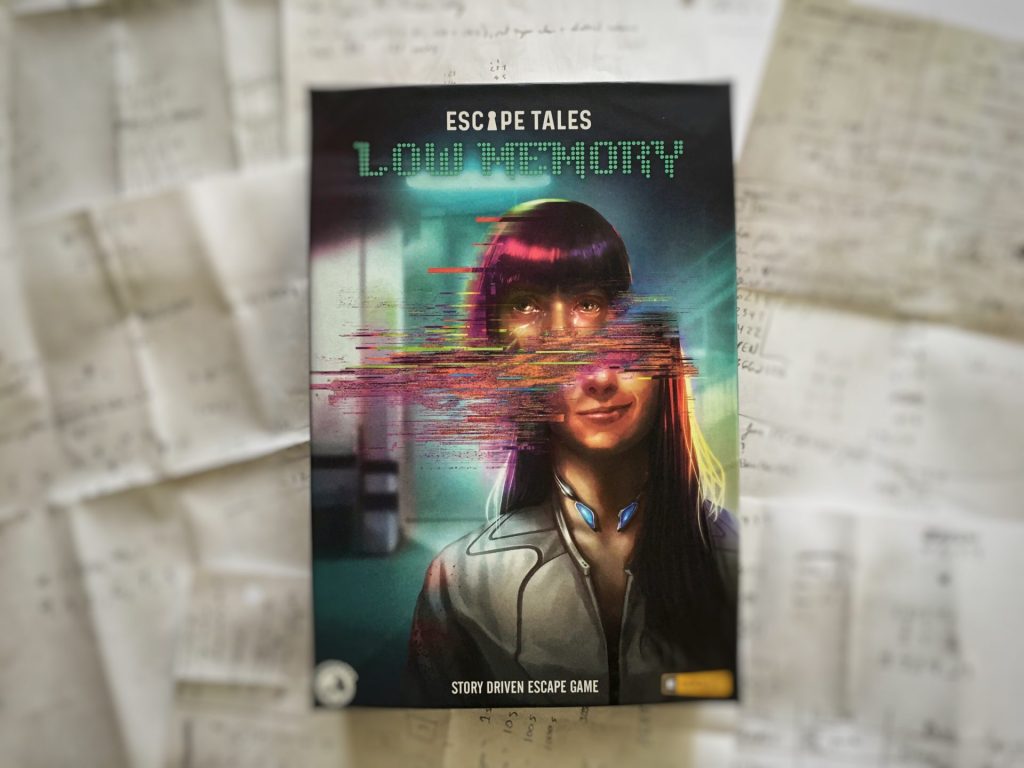
I also enjoyed Low Memory’s story a little more than The Awakening. Let’s be clear: neither of these games are meant to be played with a young audience. Each of them tell dark stories that twist your emotions and force you to make morally tough choices. The Awakening was also very grim; Low Memory is a little less so. To give you some context, the overall story in Escape Tales: Low Memory felt like it could be included in Netflix’s Black Mirror series. While each episode tackles a different subject and some are “happier” than others, you’re still left with an unsettled feeling by the end of it. The same can be said for the two Escape Tales games.

Escape Tales: Low Memory is by no means the perfect escape room game and with all this praise, I do have a couple of things that made me grumble during gameplay. The first is that there were a number of spelling and grammar mistakes in my English copy and it’s clear the text has been translated. Thankfully, unlike some other escape room games, these errors didn’t detract from the story or ruin any puzzles.

My other complaint is that there is no puzzle solution guide or walkthrough; some of the hints, even at their most detailed level, can feel vague — especially when you are already feeling a little lost. After agonizing over a puzzle for what feels like ages, you don’t want to have to work backwards to understand how the answer to a puzzle was found; you just want something to explain it to you. I understand that adding a solution to accompany the answer in the app might be too overwhelming or hard to program, but I would at least appreciate a separate, downloadable walkthrough like Escape Room: The Game or Unlock! does.
As incredible as I think Escape Tales: Low Memory is, I know it won’t be for everyone. The rulebook reminds players more than once that they are about to play a long and very challenging game. Initially I didn’t find the game too difficult, but that’s because I went into the Low Memory knowing to expect a very complex and math-heavy puzzle experience. However, the game’s difficulty does ramp up as you progress through. For example, the first file was mostly a linear experience with a few different branches and small puzzles that required one or two pieces of information to solve. The second file required more pieces of information per puzzle and by the third and final file, I was working with seven to eight different cards to solve a single puzzle.
So why play a game that is so hard and long? Well, my favourite escape room puzzles are math and logic ones so a game that focuses on these kinds of puzzles is right up my alley. On top of that, I find the story and its progression over the course of the game very engaging and the endings make all the hard work so satisfying and worthwhile. Ultimately you will know whether this is the game for you. If you can appreciate a gripping story alongside a very challenging puzzle-solving experience that’s centred around math and logic, you’ll love Escape Tales: Low Memory. Just make sure you’re also prepared to handle some of the darker aspects of its gameplay.











Add Comment